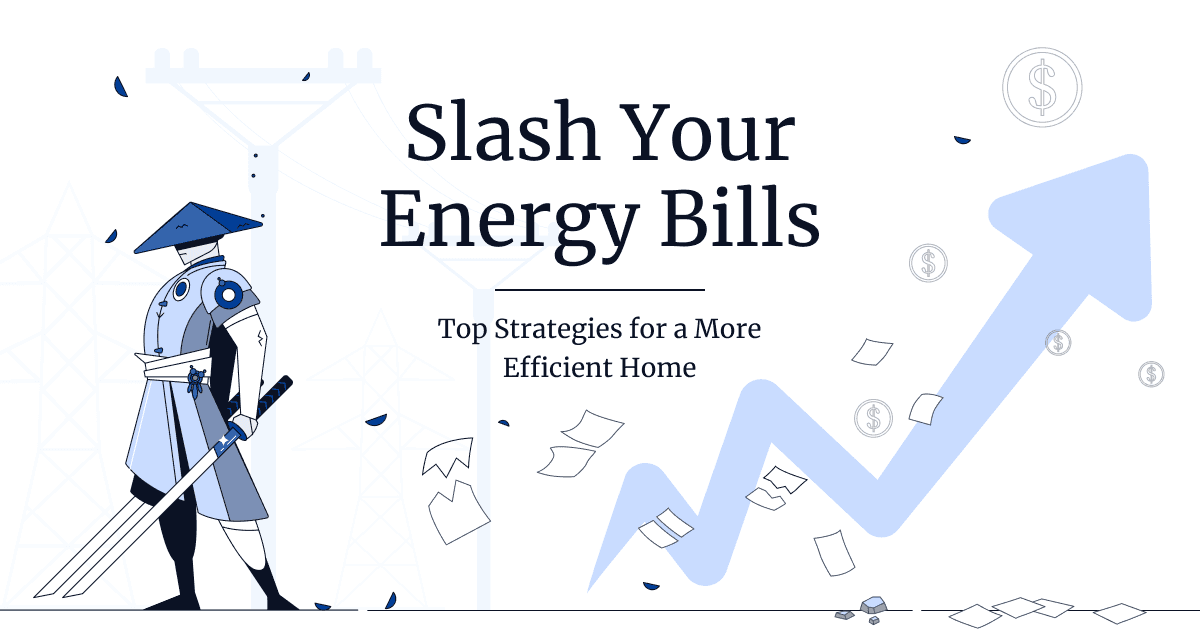As a homeowner, you have the ability to reduce your home's energy consumption, thereby reducing your monthly utility expenditures, saving money, and embracing a more sustainable lifestyle. Homeowners have various tools at their disposal to decrease energy usage. Lowering energy consumption not only helps reduce utility bills and save you a significant amount of money, but it also plays a crucial role in reducing your carbon footprint and protecting the environment.
Why You Should Reduce Your Home's Energy Consumption
Many homeowners in the U.S. struggle with high energy bills. As electricity and gas costs rise, lowering your home's energy consumption can aid in reducing monthly bills. According to the U.S. Bureau of Labor Statistics, the average American household spends $429.33 monthly on utility bills. The U.S. Energy Information Administration discovered that the average U.S. residential electric utility customer purchased about 899 kWh per month of electricity in 2022. Energy bills can differ based on the state, utility, and household — but regardless, you can still reduce your energy costs. Factors specific to your home might include the age of appliances, house size, insulation, and lifestyle choices. Many of these can be rectified with quick modifications or home improvement projects.
One strategy homeowners can utilize to decrease utility costs is residential solar. A home solar panel system not only powers your home with clean energy but also saves you money on electricity bills. Monitoring your home's energy consumption and utility bills is essential as the two are interconnected. Understanding your household's energy consumption pattern is crucial to devising suitable responses.
5 Other "Nice" Strategies to Reduce Your Home's Energy Consumption
1. Opt for Energy-Efficient Appliances
When purchasing new appliances, consider investing in energy-efficient ones. While they may have a higher initial cost, their lower annual operating expenses ensure long-term savings. This reassurance of future savings is a key benefit of energy efficiency for homeowners, providing a sense of confidence in their investment.
Advantages of Upgrading Your Appliances:
Energy-efficient appliances reduce energy usage and help save on utility bills.
Energy Star-labeled appliances use less water than traditional appliances.
Energy-efficient appliances are environmentally friendly.
How to Shop for New Appliances
Shopping for new appliances can be a daunting task, but it's also an opportunity to lower your utility bills. When buying appliances, there are two labels you should pay attention to — the Energy Star and EnergyGuide labels. The Energy Star label should be your priority for all appliance purchases. Products with this label are exceptional in terms of energy and time efficiency, as well as quality. The U.S. Environmental Protection Agency (EPA) sets strict standards for Energy Star appliances, ensuring maximum efficiency and sustainability. If you're looking to reduce your energy consumption, lower your energy bills, and contribute to a greener environment, then Energy Star appliances are the way to go.
2. Invest in Insulation for Your Home
Many costs contribute to your utility bill, but heating and cooling expenses take the lead, accounting for over 20% of home electricity consumption. As our summers get hotter and winters colder, many homeowners likely rely heavily on their home heating/cooling systems. Enhancing your home's insulation is an excellent method to increase energy efficiency, lower heating and cooling costs, and improve overall comfort. Insulation shields your home from external weather and maintains a comfortable home temperature. A well-insulated home retains cool air during hot summers and, conversely, keeps warm air during cold winters.
How to Upgrade Your Home's Insulation?
Perform an Energy Audit: Hire a professional or conduct a DIY energy audit to identify areas where insulation is deficient or can be improved.
Check Existing Insulation: Inspect the attic, walls, floors, basement, and crawl spaces to gauge the condition and type of insulation already in place.
Seal Ductwork: Ensure heating and cooling ducts are correctly sealed to prevent air leakage.
Choose the Right Insulation Type for Projects: Pick insulation materials based on the insulated area, budget, and climate. Common types include fiberglass, cellulose, spray foam, and rigid foam boards.
Consider Thermal Barriers
Radiant Barriers: Install radiant barriers in the attic to reflect heat away during hot weather, reducing cooling costs.
Insulated Siding: Consider adding insulated siding to enhance the overall thermal efficiency of your home's exterior walls.
Insulation for Parts of Your Home
Insulate Attic Access: Add insulation to the attic hatch or door to prevent heat loss.
Attic Insulation: Insulating the attic is one of the most impactful ways to boost energy efficiency. Options include fiberglass batts, blown-in cellulose, or spray foam insulation.
Wall Insulation: If walls are poorly insulated, consider adding insulation. This might involve blown-in insulation for existing walls or batt insulation during renovations.
Floor Insulation: Insulate floors above unconditioned spaces such as garages, basements, and crawl spaces.
Other Ways to Enhance Insulation
While wall insulation can be costly, there are other ways to improve your home's insulation. Ensure you weather-strip doors and windows, sealing your home from the outdoors. If you can see light peeking through your closed exterior doors, you need to weather-strip these doors and halt air leakage. If you see the light coming through the edges of your windows, re-caulk tiny cracks and weather-proof your home.
3. Switch to LED Lightbulbs
LED bulbs are the most energy-efficient lighting technology today. They boast many advantages that extend beyond reducing energy consumption. LEDs use less energy, last longer, are more durable, and could even offer superior light quality than conventional incandescent bulbs. Incandescent bulbs consume more energy, have shorter lifespans, and can produce heat (and inflate the cost of climate control). When shopping for LEDs, homeowners can look for an Energy Star label.
The Benefits of LEDs
LED bulbs use up to 90% less energy than incandescent bulbs.
Last at least 15 times longer than incandescent bulbs.
Saves around $55 in electricity costs over its lifetime.
Produce 70-90% less heat than incandescent bulbs.
Remember, LEDs can be excellent for your home's lights and replace old holiday lights, garden lighting, and other lighting applications. Due to festive string lights and electronic decorations, utility costs and consumption can rise over the holiday season.
4. Switch to a Smart Thermostat
Similar to your phone, refrigerator, and television — your thermostat can be smart too. Smart thermostats can adjust your home's temperature, heating, and cooling settings automatically. Your smart thermostat will connect to your home's Wi-Fi network, allowing you to control it via your smartphone, tablet, or computer. Many smart thermostats, such as an AmazonAlexa or Google Home, can also connect to your home's automation system. Smart thermostats help save energy by learning your household's habits and controlling your home's climate accordingly. For example, your thermostat can lower the heat while parents are at work and children are at school. Just before your family arrives home, your thermostat can raise the temperature — providing comfort and saving money. Energy Star says a certified smart thermostat can save around 8% of heating and cooling bills.
5. Monitor Your Water Usage
Consider how much water your home consumes. Hot water uses more energy than cold water, usually via electricity or gas. You can reduce your home's energy consumption by using less hot water. We're not suggesting colder showers — although there could be health benefits to colder showers — instead, there are various methods to consume less energy on water usage.
How to Use Less Energy on Water
You can wash your clothes using cool or cold water — which can be better for your clothes.
You can set a temperature range on your water heater, lowering the maximum temperature. This can help save money and avoid burning your hands.
Wash your dishes in the dishwasher instead of hand-washing them. Dishwashers are more efficient and use less water per dish.
Repair leaky faucets to avoid unnecessary water and energy loss.
An Efficient Home is a Nyce Home
Choosing Nyce for your solar energy and battery storage, along with the strategies mentioned above, is the best way to take control of your home's energy consumption. Transitioning to solar power with Nyce can significantly reduce your electricity bills and provide stable energy costs, protecting you from increasing utility rates. Our customized solar solutions and advanced battery storage options, such as the Tesla Powerwall 3 and Enphase IQ Battery, enable you to optimize energy efficiency, reduce reliance on the grid, and have a backup power source during outages or peak demand periods. For those in hurricane-prone areas like Florida, pairing battery storage with solar provides extra resilience, as highlighted in our article on energy solutions during hurricanes. With Nyce, you're not just investing in solar; you're taking control of your home and future.






